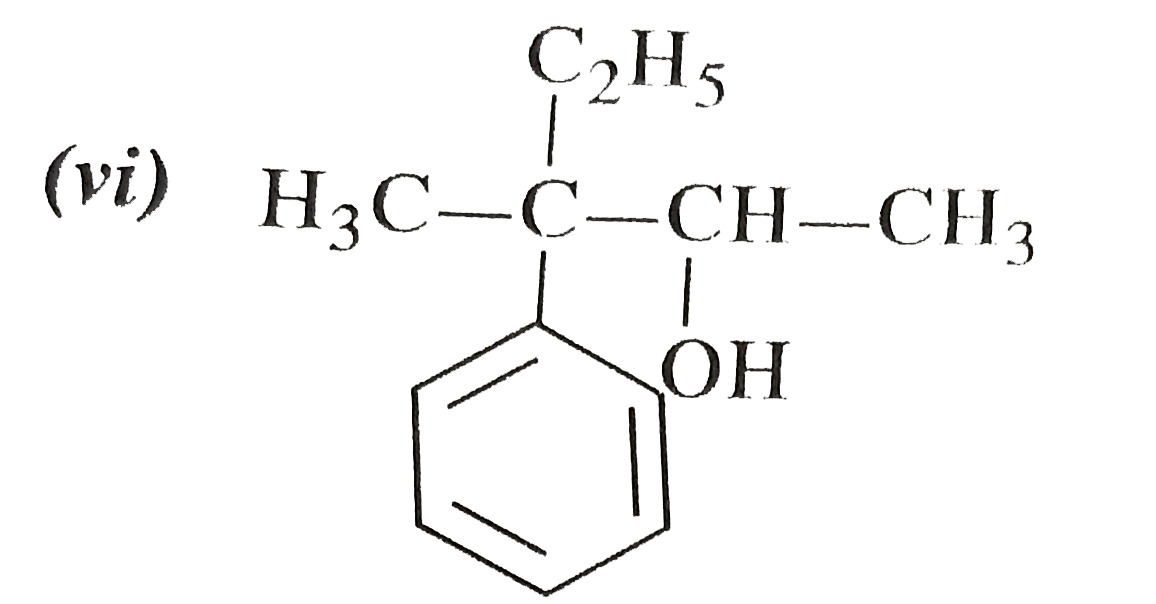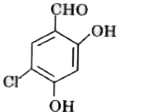Match the following :
List - I List - II(A)CH3−CH|NH2−CH2−O||C−OH(p) Exists as Zwitter ion in solid form(B)CH3−CH2−−CH|NH2COOH(q) On heating given diastereomeric product(C)H2N−CH2.CH2CH2−O||COH(r ) On heating given a cyclic product(D)H2N−CH2−COOH(s) Treatment of ninhydrin gives blue colourSolution in Telugu
The correct Answer is:A - q; B-pqrs; C-r; D-p,r
(A) CH3−C | NH2H−CH2−O||C−OH→ On heating gives diastereomeric product.
(B) CH3−CH2−C | NH2H−COOH→ Exists as Zwitter ion in solid form, On heating gives diastereomeric product, On heating gives a cyclic product, Treatment of ninhydrin gives blue colour.
(C ) H2N−CH2.CH2CH2−O||COH→ On heating a cyclic product
(D) H2N−CH2−COOH→ Exists as Zwitter ion in solid form, On heating gives a cyclic product.
Topper's Solved these Questions
- BOOK - AAKASH SERIESCHAPTER - PROTEINS AND NUCLEIC ACIDS EXERCISE - PRACTICE SHEET - 130videos
PROTEINS AND NUCLEIC ACIDS
- BOOK - AAKASH SERIESCHAPTER - PROTEINS AND NUCLEIC ACIDS EXERCISE - PRACTICE SHEET - 230videos
PROTEINS AND NUCLEIC ACIDS
- BOOK - AAKASH SERIESCHAPTER - PROTEINS AND NUCLEIC ACIDS EXERCISE - LEVEL - II LECTURE SHEET (EXERCISE - II)4videos
PROTEINS AND NUCLEIC ACIDS
- BOOK - AAKASH SERIESCHAPTER - PRINCIPLES OF METALLURGYEXERCISE - SUBJECTIVE EXERCISE-2 (LONG ANSWER QUESTIONS )7videos
PRINCIPLES OF METALLURGY
- BOOK - AAKASH SERIESCHAPTER - REDOX REACTONSEXERCISE - Questions For Descriptive Answers27videos
REDOX REACTONS
Similar Questions
Which of the following statements is/are wrong
04:23View SolutionWhich of the following is correct with respect to the amino acid compostion of proteins ?
03:47View SolutionHOOC−CH2−C | NH2H−COOHpKa1(−COOH)pKa2(−NH2)pKa3(Acid or base of −R) Aspartic acid 2.1 9.8 3.9HOOC−C | NH2H−(CH2)4−NH2pKa1(−COOH)pKa2(−NH2)pKa3(Acid or base of −R) Lysine 2.2 9.0 10.5HOOC−C | NH2H−CH−OH Threonine 2.6 10.4HOOC−C | NH2H−CH2CH2CONH2 Glutamine 2.2 9.1
The aqueous solution of lysine is neutral at02:07View SolutionWrite a note on ore dressing methods in metallurgy.
03:06View SolutionHow are no electron transfer reactions different from redox reactions ?
05:40View SolutionWrite the IUPAc name of the following compound :
(a) CH3−CH2−CH3∣CH−CH=CH−CH2−CH3
(b) CH3−CH2−CH3∣CH−CH2−CH3∣CH−CH∣CH2∣CH2∣CH−CH3∣CH3−CH=CH3∣C−CH3View SolutionThe releative rate or acid catalyssed dehydration of following alcohols would be:
(P) Ph−CH3∣C−CH∣OH−CH3
(Q) Ph−CH3∣C−CH2−CH2−OH
(R ) Ph−−CH3∣CH∣OH−CH2CH3
Ph−−CH3∣CH∣CH3−CH2OH02:57View SolutionCH_(3)-underset(CH_(3))underset(|)(CH)-CH=CH-CH_(2)-overset(O)overset(||)(C)-OH
06:45View Solution{:( " "HOCH_(2)), (" "|), (H_(2)C=CH-CH_(2)-CH_(2)-C-OH), (" "|),(" "CH_(2)-CH_(3)):} underset(TsOH)overset(CH_(3)-overset(O)overset(||)(C)-CH_(3))(to)(A)overset(O_(3))underset((CH_(3))_(2)S)(to)(B)+ HCHO Product (B) is :
02:28View SolutionThe releative rate or acid catalyssed dehydration of following alcohols would be: (P) Ph-overset(CH_(3))overset(|)(C)-underset(OH)underset(|)(CH)-CH_(3) (Q) Ph-overset(CH_(3))overset(|)(C)-CH_(2)-CH_(2)-OH (R ) Ph--underset(OH)underset(|)overset(CH_(3))overset(|)(CH)-CH_(2)CH_(3) Ph--underset(CH_(3))underset(|)overset(CH_(3))overset(|)(CH)-CH_(2)OH
View SolutionGive the IUPAC names of the following compounds:
(i)C6H5−CH2−CH2−OH (ii)CH3−CH3∣C∣CH3−CH2−CH2−OH
(iii)[(CH3)2CH]3COH. (iv)CH3−CH∣OH−CH2−CH2−O−CH2CH3
(v)CH3−CH2−CH∣Cl−CH∣CH3−CH3∣C∣OH−CH3 (vi)
(vii)(CH3)3COH (viii)CH3−CH∣CH3−CH∣OH−CH2−CH∣CH3−CH3
(ix) CH2OH |CH2−CH2−CH−CH−CH−CH3 | | CH2Cl CH3, (x) CH3−C=C−CH2OH | | CH3Br
(xi) CH2=CH−CH∣OH−CH2−CH3, (xii) CH2OH |CH3−CH−CH2−CH−CH−CH3 | | CH3 OHView SolutionWrite the IUPAC names of the following compounds (i) CH_(3)-CH_(2)-overset(O)overset(||)(C)-CH_(2)-overset(O)overset(||)(C)-CH_(3) (ii) CH_(3)-overset(O)overset(||)(C)-CH_(2)-CH_(2)-CH_(2)-CH_(2)-COOH (iii) CH_(3)-underset(C_(2)H_(5))underset(|)(CH)-underset(C_(2)H_(5))underset(|)(CH)-CH_(3)
View Solutionनिम्न यौगिकों को IUPAC नाम लिखिए-
(i)CH3−NH2∣CH−CH∣CH3−CH2NH2(ii)CH2−CH2−CH2CH3∣N−CH2−C∣CH−CH3
(iii)CH−NH2∣CH−CH2OH(iv)CH3−NH2∣CH−CH2−CH∣CH3−COOH02:43View SolutionName the following compounds according to IUPAC system. (i) CH_(3) - CH_(2) - underset (CH_(2)Cl) underset(|)(CH) - overset (CH_(2)OH) overset(|) (CH) - underset (CH_(3)) underset (|) (CH) - CH_(3) CH_(3)- underset (CH_(3)) underset(|) (CH) -CH_(2) - underset(OH) underset(|) (CH) - overset (CH_(2)OH) overset(|) (CH) - CH_(2) (iii) (iv) H_(2)C = CH - underset (OH)underset (|) (CH) - CH_(2) - CH_(2) - CH_(3) (v) CH_(3) - underset (CH_(3)) underset ( |) C = underset (Br)underset(|) C - CH_(2)OH
03:28View SolutionGive IUPAC names of the following compounds:
(a) CH3−C∣OHH−CH2−C∣OHH−C∣C2H5H−CH2CH3 (b) CH3−C∣OHH−C∣OHH−CH3
(c)CH3C∣OHHCH2C∣CH3HCH2CH2CH2CH3 (d) CH3C∣CH3H−C∣OHH−CH3∣C∣CH3−CH3
(e) CH3C∣OHHC∣OHHCH2OH (f) C6H5CH2OH
(g) CH3CH2CHCH4OH (h) CH3CH2CH2OH∣C∣C6H5CH2CH3
(i) CH3OH∣CHCH2OH∣CHC∣CH3H−CH3 (j) 01:13View Solution
01:13View Solution

